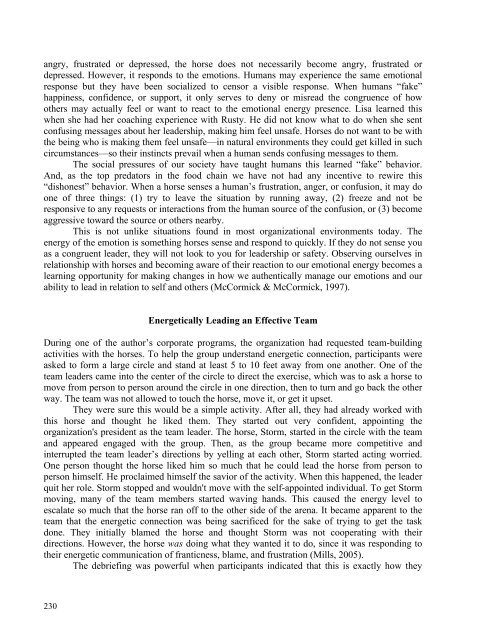Journal of Research in Innovative Teaching - National University
Journal of Research in Innovative Teaching - National University
Journal of Research in Innovative Teaching - National University
You also want an ePaper? Increase the reach of your titles
YUMPU automatically turns print PDFs into web optimized ePapers that Google loves.
angry, frustrated or depressed, the horse does not necessarily become angry, frustrated or<br />
depressed. However, it responds to the emotions. Humans may experience the same emotional<br />
response but they have been socialized to censor a visible response. When humans “fake”<br />
happ<strong>in</strong>ess, confidence, or support, it only serves to deny or misread the congruence <strong>of</strong> how<br />
others may actually feel or want to react to the emotional energy presence. Lisa learned this<br />
when she had her coach<strong>in</strong>g experience with Rusty. He did not know what to do when she sent<br />
confus<strong>in</strong>g messages about her leadership, mak<strong>in</strong>g him feel unsafe. Horses do not want to be with<br />
the be<strong>in</strong>g who is mak<strong>in</strong>g them feel unsafe—<strong>in</strong> natural environments they could get killed <strong>in</strong> such<br />
circumstances—so their <strong>in</strong>st<strong>in</strong>cts prevail when a human sends confus<strong>in</strong>g messages to them.<br />
The social pressures <strong>of</strong> our society have taught humans this learned “fake” behavior.<br />
And, as the top predators <strong>in</strong> the food cha<strong>in</strong> we have not had any <strong>in</strong>centive to rewire this<br />
“dishonest” behavior. When a horse senses a human’s frustration, anger, or confusion, it may do<br />
one <strong>of</strong> three th<strong>in</strong>gs: (1) try to leave the situation by runn<strong>in</strong>g away, (2) freeze and not be<br />
responsive to any requests or <strong>in</strong>teractions from the human source <strong>of</strong> the confusion, or (3) become<br />
aggressive toward the source or others nearby.<br />
This is not unlike situations found <strong>in</strong> most organizational environments today. The<br />
energy <strong>of</strong> the emotion is someth<strong>in</strong>g horses sense and respond to quickly. If they do not sense you<br />
as a congruent leader, they will not look to you for leadership or safety. Observ<strong>in</strong>g ourselves <strong>in</strong><br />
relationship with horses and becom<strong>in</strong>g aware <strong>of</strong> their reaction to our emotional energy becomes a<br />
learn<strong>in</strong>g opportunity for mak<strong>in</strong>g changes <strong>in</strong> how we authentically manage our emotions and our<br />
ability to lead <strong>in</strong> relation to self and others (McCormick & McCormick, 1997).<br />
Energetically Lead<strong>in</strong>g an Effective Team<br />
Dur<strong>in</strong>g one <strong>of</strong> the author’s corporate programs, the organization had requested team-build<strong>in</strong>g<br />
activities with the horses. To help the group understand energetic connection, participants were<br />
asked to form a large circle and stand at least 5 to 10 feet away from one another. One <strong>of</strong> the<br />
team leaders came <strong>in</strong>to the center <strong>of</strong> the circle to direct the exercise, which was to ask a horse to<br />
move from person to person around the circle <strong>in</strong> one direction, then to turn and go back the other<br />
way. The team was not allowed to touch the horse, move it, or get it upset.<br />
They were sure this would be a simple activity. After all, they had already worked with<br />
this horse and thought he liked them. They started out very confident, appo<strong>in</strong>t<strong>in</strong>g the<br />
organization's president as the team leader. The horse, Storm, started <strong>in</strong> the circle with the team<br />
and appeared engaged with the group. Then, as the group became more competitive and<br />
<strong>in</strong>terrupted the team leader’s directions by yell<strong>in</strong>g at each other, Storm started act<strong>in</strong>g worried.<br />
One person thought the horse liked him so much that he could lead the horse from person to<br />
person himself. He proclaimed himself the savior <strong>of</strong> the activity. When this happened, the leader<br />
quit her role. Storm stopped and wouldn't move with the self-appo<strong>in</strong>ted <strong>in</strong>dividual. To get Storm<br />
mov<strong>in</strong>g, many <strong>of</strong> the team members started wav<strong>in</strong>g hands. This caused the energy level to<br />
escalate so much that the horse ran <strong>of</strong>f to the other side <strong>of</strong> the arena. It became apparent to the<br />
team that the energetic connection was be<strong>in</strong>g sacrificed for the sake <strong>of</strong> try<strong>in</strong>g to get the task<br />
done. They <strong>in</strong>itially blamed the horse and thought Storm was not cooperat<strong>in</strong>g with their<br />
directions. However, the horse was do<strong>in</strong>g what they wanted it to do, s<strong>in</strong>ce it was respond<strong>in</strong>g to<br />
their energetic communication <strong>of</strong> franticness, blame, and frustration (Mills, 2005).<br />
The debrief<strong>in</strong>g was powerful when participants <strong>in</strong>dicated that this is exactly how they<br />
230

















